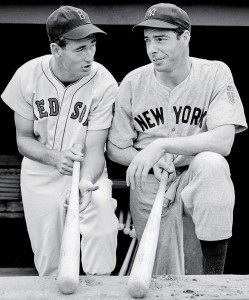Joe DiMaggio’s Hitting Streak Will Never Be Duplicated

No major leaguer has come close to matching Joe DiMaggio's record hitting streak of 56 straight games.
The Major League Baseball players of today are capable of accomplishing amazing feats, but I am going to go out on a limb and predict that no major leaguer of today will ever hit in 56 consecutive regular season games.
It was 70 years ago today that one of the most amazing individual streaks in sports history ended following an unbelievable two month performance by future Hall of Famer Joe DiMaggio.
After knocking out a hit in every game from May 15th through July 16th, the luck finally ran out for DiMaggio in a game against the Cleveland Indians. As he had done throughout most of the streak, DiMaggio hit the ball hard, but unlike in previous days, there was always someone there to make the play.
His best chance to extend the streak came in his first at bat when DiMaggio laced the ball down the third base line. Unfortunately, third baseman Ken Keltner was playing deep and was able to grab the ball and throw DiMaggio out at first.
After walking in the fourth inning, DiMaggio hit another drive toward third in the seventh inning, but Keltner made another play to throw out the Yankee Clipper.
With the bases loaded and one out in the eighth inning, DiMaggio managed not to hit the ball to Keltner, but instead grounded to shortstop Lou Boudreau who turned it into an inning ending double play.
During the streak, DiMaggio hit .408 with 15 home runs and 55 runs batted in. He had multiple hits 22 times, including four games with four hits.
What is really neat when looking back at the streak is how it seemed to captivate the American public during a time when distractions from the perils of the world were infrequent and welcomed. Just months following the conclusion of the baseball season, America would be at war and life would quickly change for many Americans, including DiMaggio.
Included below is the famous “Joltin Joe DiMaggio” song that became a favorite in 1941 and helped turn the youngster from San Francisco into an American icon.
We all know that in the last 70 years several baseball greats including Pete Rose and Paul Molitor have made runs at the record, but no player has truly gotten close. The closest that any player has gotten over the last decade was a 38 game streak by Jimmy Rollins during the 2005-2006 seasons.
Earlier this year Andre Eithier of the Los Angeles Dodgers started to gain attention when he had a hit in every game during the month of April. However, he would have had to get a hit in every game in May and into June to match DiMaggio’s record and his streak ended at 30 games on May 7th.
It should be noted that DiMaggio’s 1941 streak was actually not even the longest of his career. While playing in the Pacific Coast League in 1933, the then 18-year-old DiMaggio hit safely in 61 consecutive games, albeit the competition was not quite as staunch as he faced eight years later, but it illustrates that he possessed a talent and ability to reach consistency from the very beginning.
To magnify just how hot DiMaggio was during the 1941 streak, he rebounded from his hitless game to start another streak that reached 16 straight games. Thus, DiMaggio hit in 72 of 73 games. Even the best players of today will never reach that level of sustained performance.
Interestingly, at the end of the season DiMaggio was named the American League MVP after finishing the season with 30 home runs, 125 RBIs and a .357 batting average. He ended up winning the award over Ted Williams, who hit for nearly as high an average for the entire season (.406) as DiMaggio did during his streak and led the AL with 37 home runs while finishing with 120 RBI.
When you consider that over the last 70 years no player has been able to match either the hitting streak of DiMaggio or the season batting average of Williams, it is easy to understand why the 1941 season was without question one for the ages and a record-setting season that will never be equaled.

Thanks , I’ve just been searching for info approximately this subject for a while and yours is the
best I’ve discovered so far. However, what about the bottom line?
Are you positive in regards to the supply?